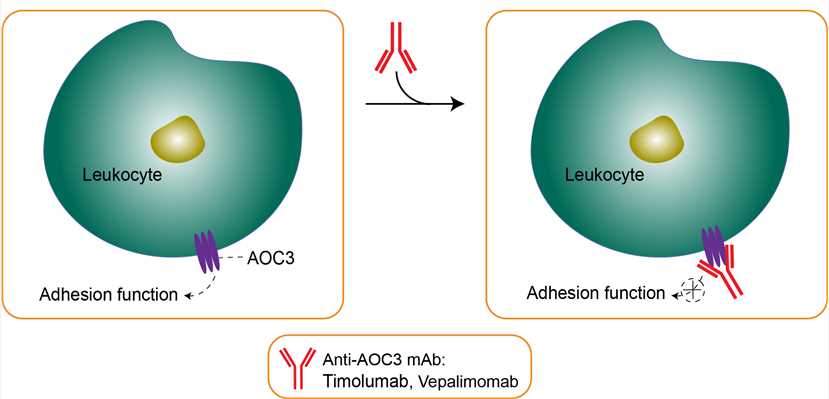Vepalimomab Overview
Introduction of Vepalimomab
Vepalimomab is an experimental mouse monoclonal antibody which was intended for the treatment of inflammations. It could block the adhesion function of endothelial cell-surface oxidase (amine oxidase, copper containing-3, AOC3), thereby diminishing leucocyte entry into sites of tissue inflammation. However, development of the drug was discontinued in 2002. Vepalimomab dose-dependently labelled AOC3 in the inflamed skin. In the phase 1 clinical study, safety of blocking AOC3 in patients with contact dermatitis, this drug, 0.05-0.50 mg/kg-1 was safe and well tolerated. Four of nine patients reported adverse events of mild to moderate intensity. Vepalimomab dose-dependently labelled AOC3 in the inflamed skin. Luminal upregulation of AOC3 on the endothelium upon inflammation was demonstrated for the first time in patients in vivo. Vepalimomab was found on the endothelium up to 24 hours after dosing whilst it was cleared from the circulation with an apparent half-life of 25-50 min. The results provide in vivo support for the concept of blocking AOC3 in human disease states and support previous proposals that AOC3 is a potential target molecule for inhibition of inflammatory reactions.
Mechanism of Action of Vepalimomab
Leukocyte traffic between the blood and tissues is needed for normal immune homeostasis as well as for mounting adequate inflammatory responses. The spectrum of inflammatory diseases for which the inadvertent migration of leukocytes is proving to be critical is increasing all the time. Different steps of the leukocyte extravasation cascade-tethering, rolling, activation, firm adhesion, and transmigration-can be mediated by traditional adhesion and activation molecules. Selectins and their sialomucin ligands contribute to the initial shear-dependent interactions between the vascular endothelium and blood-borne leukocytes. If rolling cells receive appropriate activating signals from chemokines, they can firmly bind to the endothelial cells. The firm adhesion and the subsequent transmigration step are mediated by leukocyte integrins and adhesion molecules belonging to the immunoglobulin superfamily. AOC3, also known as vascular adhesion protein (VAP-1) and HPAO, is a non-classical inflammation-inducible endothelial cell adhesion molecule and a potential drug development target in this clinical area. In particular, it mediates rolling and early steps in the adhesion of leukocytes to the vascular endothelium. It belongs to a unique molecular family of cell surface amine oxidases that generate H2O2 and aldehydes from monoamine substrates. The enzymatic reaction itself, and the biologically active end-products, can potentially regulate the adhesive status of the vessel wall. Thus, vascular adhesion protein-1 is an ectoenzyme that has interrelated adhesive and enzymatic functions in regulating physiological immune cell trafficking and inflammation. Vepalimomab is a mouse monoclonal antibody that targets AOC3. It could block the adhesion function of AOC3, thereby diminishing leucocyte entry into sites of tissue inflammation. The ligation between vepalimomab and vascular adhesion protein-1 inhibited lymphocyte binding to inflamed tonsils, synovium and peripheral lymph nodes.

Fig 1. Mechanism of Action of Vepalimomab
For research use only. Not intended for any clinical use.
This site is protected by reCAPTCHA and the Google Privacy Policy and Terms of Service apply.



